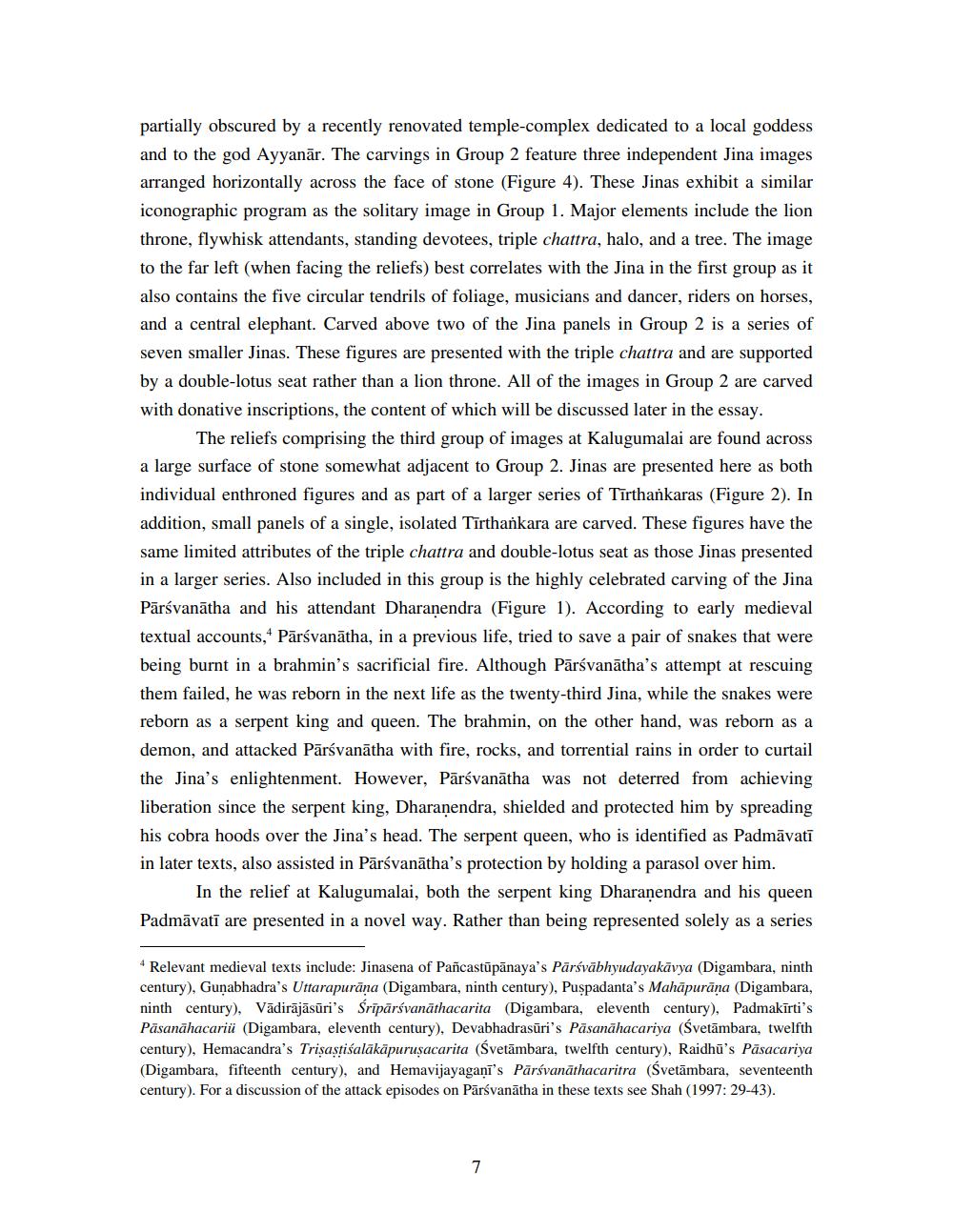________________
partially obscured by a recently renovated temple-complex dedicated to a local goddess and to the god Ayyanār. The carvings in Group 2 feature three independent Jina images arranged horizontally across the face of stone (Figure 4). These Jinas exhibit a similar iconographic program as the solitary image in Group 1. Major elements include the lion throne, flywhisk attendants, standing devotees, triple chattra, halo, and a tree. The image to the far left (when facing the reliefs) best correlates with the Jina in the first group as it also contains the five circular tendrils of foliage, musicians and dancer, riders on horses, and a central elephant. Carved above two of the Jina panels in Group 2 is a series of seven smaller Jinas. These figures are presented with the triple chattra and are supported by a double-lotus seat rather than a lion throne. All of the images in Group 2 are carved with donative inscriptions, the content of which will be discussed later in the essay.
The reliefs comprising the third group of images at Kalugumalai are found across a large surface of stone somewhat adjacent to Group 2. Jinas are presented here as both individual enthroned figures and as part of a larger series of Tīrthankaras (Figure 2). In addition, small panels of a single, isolated Tīrthankara are carved. These figures have the same limited attributes of the triple chattra and double-lotus seat as those Jinas presented in a larger series. Also included in this group is the highly celebrated carving of the Jina Pārsvanātha and his attendant Dharanendra (Figure 1). According to early medieval textual accounts, Pārsvanātha, in a previous life, tried to save a pair of snakes that were being burnt in a brahmin's sacrificial fire. Although Pārsvanātha's attempt at rescuing them failed, he was reborn in the next life as the twenty-third Jina, while the snakes were reborn as a serpent king and queen. The brahmin, on the other hand, was reborn as a demon, and attacked Pārsvanātha with fire, rocks, and torrential rains in order to curtail the Jina's enlightenment. However, Pārsvanātha was not deterred from achieving liberation since the serpent king, Dharanendra, shielded and protected him by spreading his cobra hoods over the Jina's head. The serpent queen, who is identified as Padmāvati in later texts, also assisted in Pārsvanātha's protection by holding a parasol over him.
In the relief at Kalugumalai, both the serpent king Dharanendra and his queen Padmāvatī are presented in a novel way. Rather than being represented solely as a series
* Relevant medieval texts include: Jinasena of Pancastūpānaya's Pārsvābhyudayakāvya (Digambara, ninth century), Gunabhadra's Uttarapurāna (Digambara, ninth century), Puspadanta's Mahāpurāna (Digambara, ninth century), Vādirājāsūri's Srīpārsvanāthacarita (Digambara, eleventh century), Padmakīrti's Pāsanāhacariü (Digambara, eleventh century), Devabhadrasūri's Pāsanāhacariya (Svetambara, twelfth century), Hemacandra's Trisastiśalākāpuruşacarita (Svetāmbara, twelfth century), Raidhū's Pāsacariya (Digambara, fifteenth century), and Hemavijayagani's Pārsvanāthacaritra (Svetambara, seventeenth century). For a discussion of the attack episodes on Pārsvanātha in these texts see Shah (1997: 29-43).




